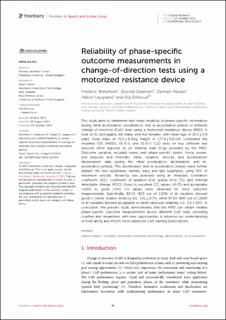| dc.contributor.author | Westheim, Frederic | |
| dc.contributor.author | Gløersen, Øyvind | |
| dc.contributor.author | Harper, Damian | |
| dc.contributor.author | Laugsand, Håkon Nilsen | |
| dc.contributor.author | Eriksrud, Ola | |
| dc.date.accessioned | 2024-01-05T08:38:52Z | |
| dc.date.available | 2024-01-05T08:38:52Z | |
| dc.date.created | 2023-11-09T10:07:54Z | |
| dc.date.issued | 2023 | |
| dc.identifier.citation | Frontiers in Sports and Active Living. 2023, 5, Artikkel 1212414. | en_US |
| dc.identifier.issn | 2624-9367 | |
| dc.identifier.uri | https://hdl.handle.net/11250/3110021 | |
| dc.description | This is an open-access article distributed under the terms of the Creative Commons Attribution License (CC BY). The use, distribution or reproduction in other forums is permitted, provided the original author(s) and the copyright owner(s) are credited and that the original publication in this journal is cited, in accordance with accepted academic practice. No use, distribution or reproduction is permitted which does not comply with these terms. | en_US |
| dc.description.abstract | This study aims to determine test-retest reliability of phase-specific information during initial acceleration, deceleration, and re-acceleration phases of different change-of-direction (CoD) tests using a motorized resistance device (MRD). A total of 21 participants (16 males and five females, with mean age of 22.3 ± 3.9 years, body mass of 75.2 ± 6.9 kg, height of 177.9 ± 6.8 cm) completed the modified 505 (m505), 10-0-5, and 15-0-5 CoD tests on four different test sessions while exposed to an external load (3 kg) provided by the MRD. Outcome variables included overall and phase-specific kinetic (force, power, and impulse) and kinematic (time, distance, velocity, and acceleration/deceleration) data during the initial acceleration, deceleration, and re-acceleration phases. The deceleration and re-acceleration phases were further divided into two subphases, namely, early and late subphases, using 50% of maximum velocity. Reliability was assessed using an intraclass correlation coefficient (ICC), coefficient of variation (CV), typical error (TE), and minimal detectable change (MDC). Good to excellent ICC values (>0.75) and acceptable (<10%) to good (<5%) CV values were observed for most outcome measurements. Specifically, 80.1% (822 out of 1,026) of all variables showed good or better relative reliability (i.e., ICC ≥ 0.75), while 97.0% (995 out of 1,026) of all variables showed acceptable or better absolute reliability (i.e., CV < 10%). In conclusion, the present study demonstrates that the MRD can obtain reliable phase-specific outcome measurements across different CoD tests, providing coaches and researchers with new opportunities to advance our understanding of CoD ability and inform more advanced CoD training prescriptions. | en_US |
| dc.language.iso | eng | en_US |
| dc.subject | deceleration | en_US |
| dc.subject | motorized resistance technology | en_US |
| dc.subject | phase analysis | en_US |
| dc.subject | re-acceleration | en_US |
| dc.subject | reliability | en_US |
| dc.title | Reliability of phase-specific outcome measurements in change-of-direction tests using a motorized resistance device | en_US |
| dc.type | Peer reviewed | en_US |
| dc.type | Journal article | en_US |
| dc.description.version | publishedVersion | en_US |
| dc.rights.holder | © 2023 Westheim, Gløersen, Harper, Laugsand and Eriksrud | en_US |
| dc.source.pagenumber | 31 | en_US |
| dc.source.volume | 5 | en_US |
| dc.source.journal | Frontiers in Sports and Active Living | en_US |
| dc.identifier.doi | 10.3389/fspor.2023.1212414 | |
| dc.identifier.cristin | 2194397 | |
| dc.description.localcode | Institutt for fysisk prestasjonsevne / Department of Physical Performance | en_US |
| dc.source.articlenumber | 1212414 | en_US |
| cristin.ispublished | true | |
| cristin.fulltext | original | |
| cristin.qualitycode | 1 | |
